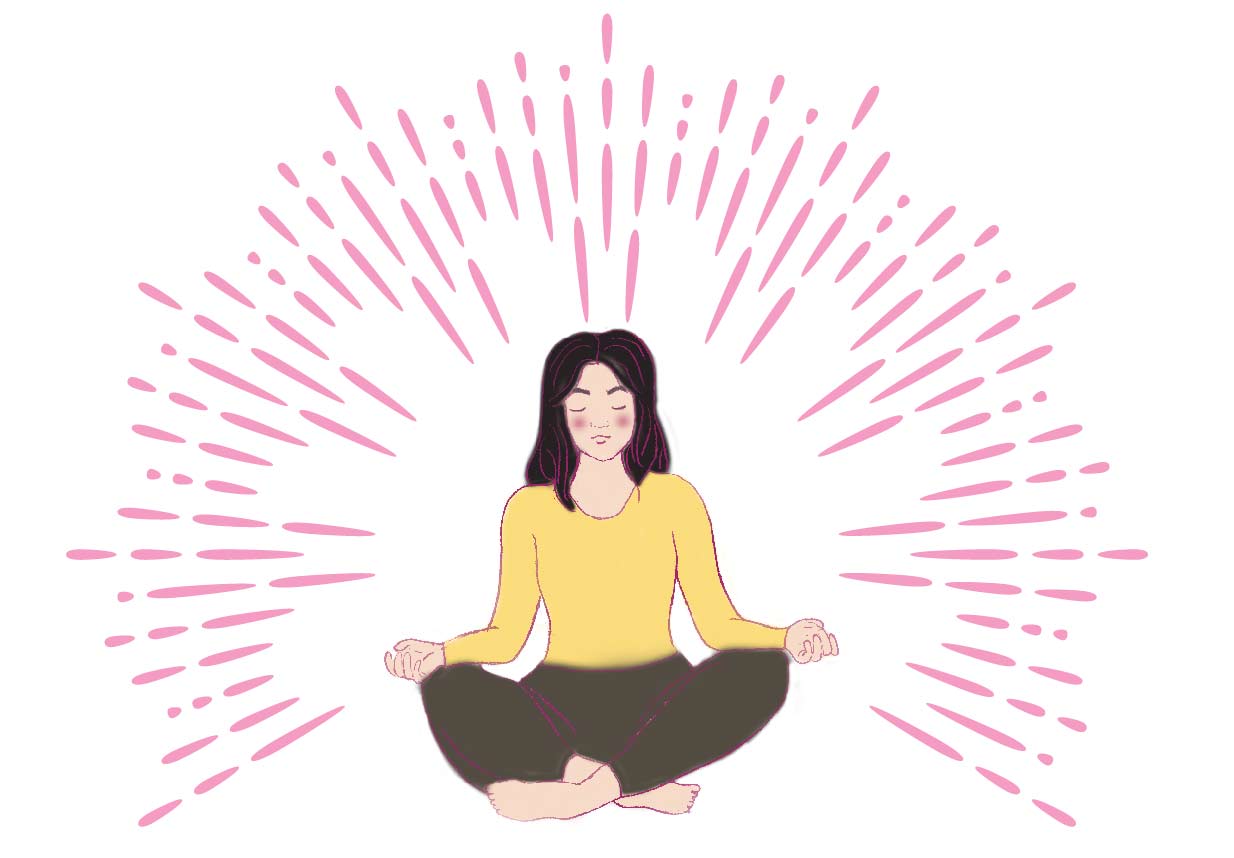Illustration by Marika Mirren
Prescription Meditation
by John Henry Scott
Dr. Michael Baime has been using meditation (sometimes called “mindfulness” or “mindful meditation”) as a form of medical treatment for his patients since the late 1980s. As a general practitioner, Baime remembers being met with skepticism from his colleagues regarding his unconventional courses of treatment, which involve focusing one’s attention to the present moment in order to achieve a psychological benefit.
“They tolerated me—what I was doing,” he said. “But, I think, kind of rolled their eyes.”
Although meditation has been part of the Western purview since the late 18th century, associations with occultism created a stigma surrounding the practice, with many scientists, doctors and academics dismissing its practical merit. Since the turn of the millennium, however, there has been a significant increase in scientific research linking the practice of meditation to real, tangible health benefits, including the treatment of anxiety, depression and addiction.
Baime thinks the use of the term “mindfulness” as opposed to “meditation” is part of an effort to come out from under the stigma surrounding the practice. The two terms can also be used as a point of distinction between the secular, health-driven practice (mindfulness) and the religious practice of seeking spiritual development or enlightenment (meditation).
In 1992, Baime founded the Penn Program for Mindfulness at Penn Medicine to help people suffering from a litany of psychological problems such as stress, anxiety, depression, trauma and loss, while continuing to spearhead scientific research on the subject.
“What I found many people needed was not what I could give them with a prescription or pill,” he said.
Dr. Michael Gawrysiak, a psychology instructor and researcher in the addiction treatment research center at the University of Pennsylvania, has done extensive work with mindfulness as a means of support for people struggling with addiction and substance abuse issues.
According to Gawrysiak, the real struggle in addiction treatment is keeping people sober rather than getting them sober in the first place. Up to 90 percent of people treated for drug and alcohol problems relapse at some point in their lives. To treat addiction is to temper the likelihood of relapse.
“Meditation helps people become more aware of their psychological interior, to recognize emotional cause and effect and increase awareness of triggers which cause a relapse,” said Gawrysiak. “It does this because it’s designed to anchor your focus to the present moment. We’re so busy all the time, we’re thinking about a million things at once. Meditation brings us back to right now, which is the only place we can make real decisions. It allows us to respond to the moment instead of react to it.”
The designation here, between response and reaction, seems to be that “response” connotes a higher level of impulse control brought on by one’s increased understanding of their emotional triggers.
Gawrysiak believes there are several reasons for the recent increase in meditation research.
“As technology progresses and we find ourselves more connected to our obligations, our stress level as a culture rises,” he said. “This leads to a search for new and healthy ways to deal with that stress, something meditation has proven itself to be.”
He also believes that successful research simply gains momentum over time. Once a study is published featuring interesting results regarding the health benefits of meditation, it inspires another. Research on the topic increases and snowballs.
Earlier this year, The New York Times featured a study from the journal Biological Psychiatry that found a link between mindfulness meditation and lowered levels of blood vessel inflammation, a sign of reduced stress. The Journal of the American Medical Association consistently publishes studies on the benefits of mindfulness. Recent findings include a link between meditation and preventing substance abuse relapse and recurrent depression.
Baime has similar ideas to Gawrysiak as to why mindfulness meditation is being taken more seriously in Western culture. “The science justifies its use for practical reasons,” he said. “It’s an antidote to some of the things that don’t work so well within our culture, such as our stress and our disconnection from ourselves.”
Both Baime and Gawrysiak meditate regularly in their personal lives.
But not everyone who meditates does so for health reasons. Many people still use the practice for spiritual development, and many religions employ meditation as a facet of their customs, most prominently Taoism and Buddhism.
George Heckert is the cofounder and manager of the Philadelphia Meditation Center (PMC) in Havertown, which teaches meditation in the Buddhist tradition. Heckert makes a distinction between the type of meditation practiced at PMC and the courses and programs run by the Penn Program for Mindfulness. Meditation at PMC is not focused on therapeutic benefit. While individuals may experience positive life changes over the course of their practice, PMC members are more focused on spiritual development than therapy.
“It’s about developing a general insight,” Heckert said. “Rather than trying to solve any one problem, it’s more about trying to look at the world in a more balanced way.” Heckert did agree that, by allowing a person to stay in the present moment, meditation could help alleviate anxiety.
“It’s hard to say, though, the exact benefits since you do this and then you can’t picture your life without it,” he said. “I’m not sure what my life would be like if I didn’t meditate.”








